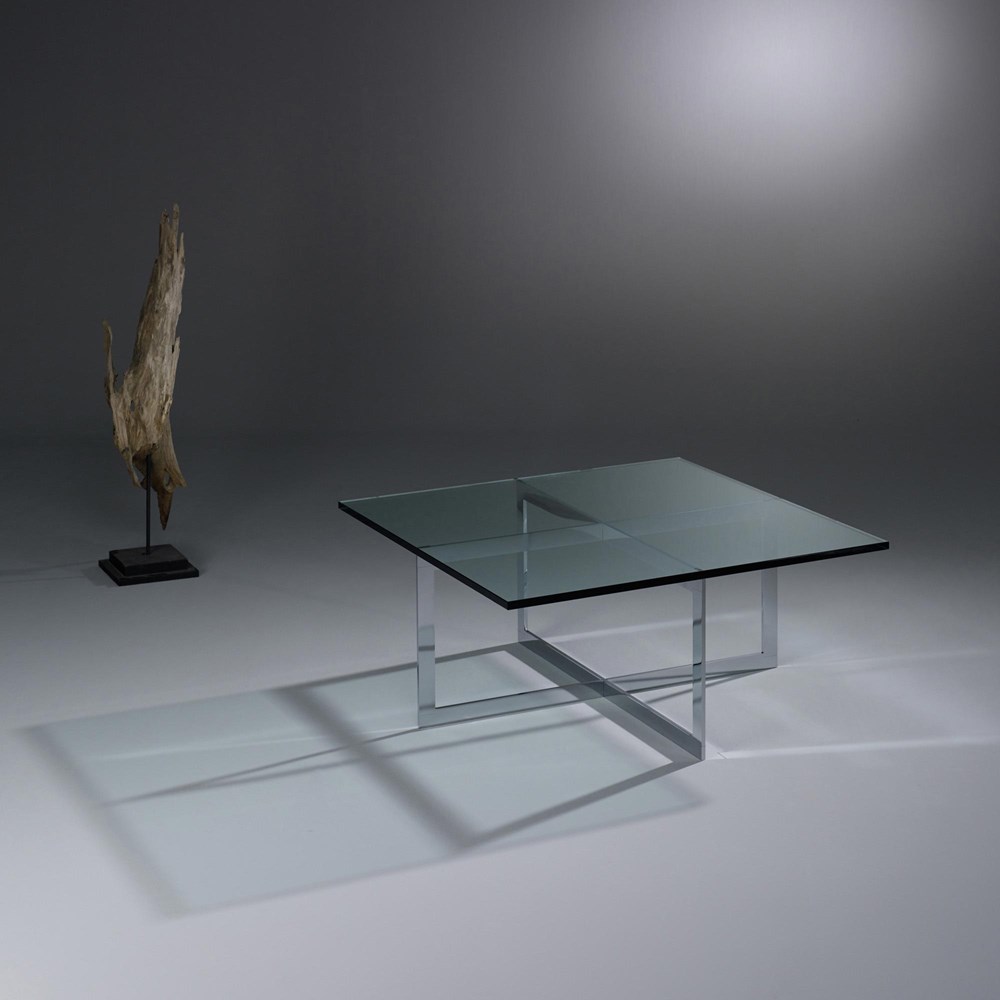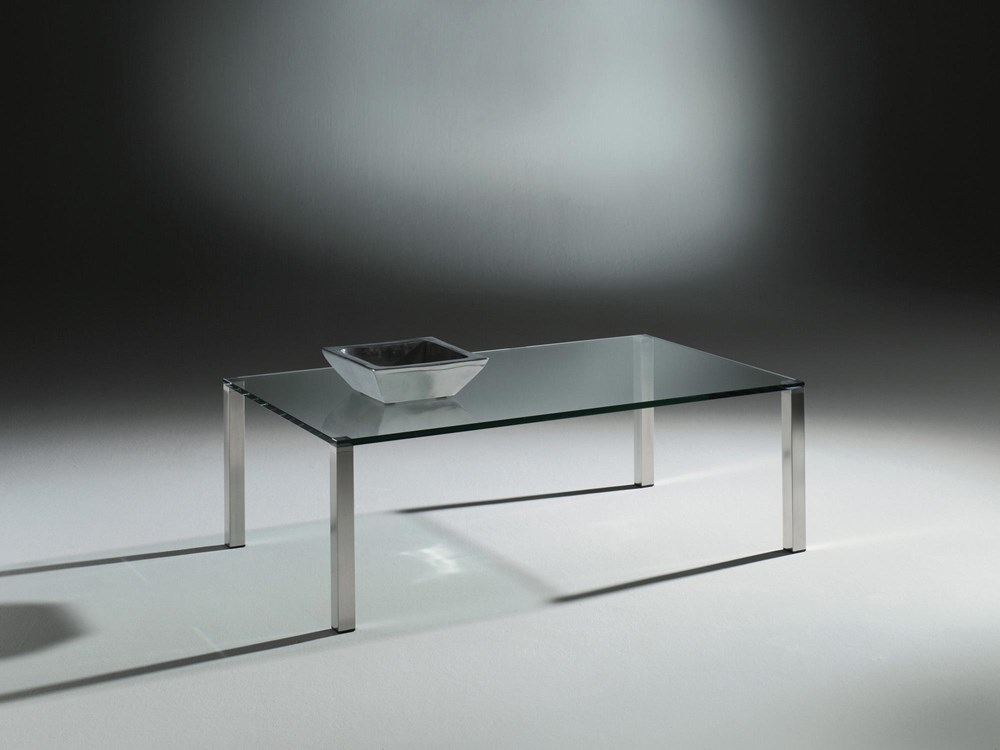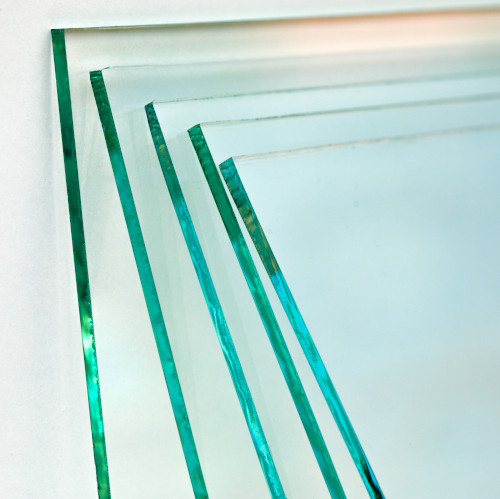-
Free Delivery in DE, AT & CH
-
Made in Germany
-
Individual Customisation Available
Author: DREIECK DESIGN editorial department
Last update: 02.08.2022
Window panes, mirrors or designer furniture: glass is a diverse material and we encounter it in many areas of everyday life. Float glass is used in almost all cases. This is flat glass, which is produced in a so-called float process and has a particularly smooth surface. Read all the important information about the manufacture and properties of float glass and special float glasses such as Optiwhite or safety glass here.

(Photo shows glass coffee table MILES, from 1.640,-- EUR)
Float glass is a so-called flat glass, which is produced in a float glass process. To do this, the molten glass is applied to a bath of liquid tin. Since the glass is lighter than tin, it floats on the surface and spreads out completely evenly.
The result is glass with an immaculately smooth surface that is free of air pockets (such as bubbles or streaks). Because of these advantages, the float glass process has largely become established in the manufacture of flat glass.
Float glass is also valued in furniture design: with its immaculately smooth surface and crystal-clear transparency, it is ideal for the production of fine glass furniture. The typical float glass shimmers slightly greenish and has a clear green to green-black color at the edges.
Glass furniture made of classic float glass exudes an elegance that goes particularly well with an upscale furnishing style. Are you looking for a fresh, modern touch? Then it is advisable to use glass furniture made of white glass, for example the extra light Optiwhite glass.
Until the 1960s, flat glass was manufactured using other methods, such as pulling, rolling or casting. The resulting glass, however, always had a slight curl or drawing strip, so that it did not appear completely clear.
In 1959, the British engineer Alastair Pilkington introduced the float glass process for the first time, and industrial float glass production began in the mid-1960s. Since then, the float glass method has increasingly replaced all other processes.

(Photo shows glass coffee table QUADRO, from 648,-- EUR)
As already mentioned, a major advantage of float glass is its completely even surface. In contrast to previous manufacturing processes, glass can be produced in the float process, which allows a clear, undistorted view.
Other properties of float glass:
These features and a comparatively inexpensive manufacturing process have led to float glass being used in a variety of ways today. Around 95% of flat glass is float glass.
Among other things, it is used for:
In many cases, float glasses are not processed as single panes: Multiple glazing made from several float glass panes is mostly used for windows, doors and facades.
Through special treatment, the flat glass can also be processed into safety, laminated and insulating glass (see the item "Float glass as safety glass").

Let's now take a closer look at the production of float glass in Detail
In the first step, the individual raw materials from which the glass is later made are mixed and melted. The following raw materials are required for glass production:
In most cases, 10-15% of recycled, cleaned glass shards are also added. The so-called batch is created from these “ingredients” in the melting furnace.
In the next step, the batch is passed to a bath of liquid tin at a temperature of approx. 1100 ° C. Because of their different density (the glass mixture is about two thirds lighter than tin), the two substances do not mix. The glass floats at the top and spreads out very evenly in all directions. The characteristic smooth surface is formed by the surface tension of the tin and the liquid glass.
Incidentally, the float glass process is a continuous process - once it is started, it runs continuously day and night as long as the plant is in operation. Glass mixture is permanently filled in on one side, and the cooled glass ribbon is pulled out and cut on the other side.
The glass is then cooled down slowly and without tension. As soon as it is “only” 600 ° C hot, the glass ribbon can be lifted off the tin bath. The glass cools further in an additional cooling furnace. It is then checked for quality, washed and cut to the desired sizes.
The thickness of the glass depends on how fast the rollers move in the cooling area. The faster these rollers are, the thinner the glass plate becomes. Usually an additional production step of stretching or upsetting is installed to control the glass thickness. The processing then takes place as follows:
The float glass is processed into safety glass for a large number of uses. These are panes of glass that crumble into many small parts if broken, or that do not even fall apart. This minimizes the risk of injuries or serves as burglary protection.
With regard to the characteristics of safety glass, two terms often appear, which we briefly explain:
One differentiates among other things the toughened safety glass (ESG), the laminated safety glass (VSG) and the partially tempered glass (TVG):
Simple float glass without safety treatment breaks into pieces of fragments that pose a great risk of injury. The fracture pattern of ESG float glass looks different: Here the glass breaks down into many small, blunt crumbs. Existing ESG has an increased flexural strength (at least 120 N / mm²) - it also generally belongs to safer shocks and stands - and an increased resistance to temperature changes (approx. 200 K).
The glass is heated to a temperature of more than 600 ° C and then suddenly cooled again. This means an internal stress in the glass and it comes to the affected properties.
Laminated safety glass (VSG) does not only consist of one pane of glass, but of several panes glued together. In between there is a tear-resistant plastic film.
The result: the glass can break, but the glass fragments do not fall to the ground. The fragments adhere to the plastic film and the glazed opening remains closed. The VSG float glass thus offers, for example, increased protection against burglars, and roof glazing and windscreens are usually made of VSG.
The partially tempered glass (TVG) is processed in a similar way to single-pane safety glass, using a thermal tempering process (heating and cooling the pane). However, cooling down is slower. The TVG float glass, with its bending strength (70 Nm / mm²) and resistance to temperature changes (100 K), lies between the normal float glass and the ESG float glass.
TVG float glass is mostly used as the basis for laminated safety glass. Because it is more stable than ordinary float glass, but forms larger fragments than the fully tempered glass. In the case of laminated safety glass made of TVG, a high residual load-bearing capacity of the pane remains when broken, which can be important for fall protection, for example.
Float glass is characterized by its slightly greenish color. Depending on the thickness and viewing angle, this is more or less strong, the green color on the edges is particularly clearly recognizable. The reason for this is the proportion of iron oxides in the glass bulk.
In the meantime, however, it is also possible to produce lighter glass by using a raw material low in iron oxide. This so-called white glass or "Optiwhite" glass looks even more transparent and shimmers more brightly turquoise. This can be an attractive option, especially for glass furniture; Aquariums are also often made from white glass.
In principle, both variants are float glass: Because this is used to refer to any flat glass that is manufactured in the float process, and the production of white flat glass is also carried out in this way. When you mention "float glass" in contrast to "white glass" or "optiwhite" glass, you usually mean the typical greenish glass.
Float glass panes surround us constantly, whether we are aware of it or not: whether we look through the windshield in the car, sunbathe in the glazed veranda or admire fine porcelain in a glass display case. Because the float glass process can be used to produce mirror-flat glass in an efficient manner that allows crystal-clear viewing.
Photo credits:
Picture 3: © sichkarenko_com – stock.adobe.com
Float glass is used in many different ways, e.g. B. for window panes, glass furniture, glass facades, mirrors, aquariums and much more.
How stable a pane of glass is is indicated by its "strength", e.g. B. their "flexural strength". The flexural strength of untreated float glass is around 45 N/mm², that of ESG float glass is at least 120 N/mm² and up to 200 N/mm². For comparison: The flexural strength of chipboard is approx. 12-25 N/mm².
Float glass refers to flat glass that was manufactured using the so-called float glass process. The molten glass floats on a tin bath, creating an even surface. It is then cooled down to the desired temperature and cut to size.